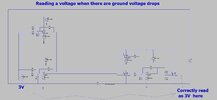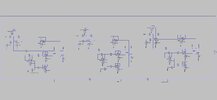Hi,
Do you know of a lower component count solution for the following?...
As you can see, there is a Diff Amp which reads a 3V source voltage…..then passes it to circuitry which is grounded to a slightly different potential….and that circuitry there must read the 3V voltage correctly.
The attached does it but is too high in component count. Do you know of a lower component count way?
Do you know of a lower component count solution for the following?...
As you can see, there is a Diff Amp which reads a 3V source voltage…..then passes it to circuitry which is grounded to a slightly different potential….and that circuitry there must read the 3V voltage correctly.
The attached does it but is too high in component count. Do you know of a lower component count way?




